The Role of ACCHS in Improving Indigenous Healthcare in Australia
VerifiedAdded on 2022/11/14
|10
|2886
|2
Report
AI Summary
This report delves into the critical role of Aboriginal Community Controlled Health Services (ACCHS) in addressing the health disparities experienced by Indigenous Australians. It explores the historical context and operational aspects of ACCHSs, highlighting their community-centric approach and focus on holistic healthcare. The report emphasizes the significance of community control, cultural competency, and self-determination in delivering effective healthcare services tailored to the unique needs of Indigenous communities. It contrasts the services provided by ACCHSs with those of General Practitioners, showcasing the barriers faced by Indigenous peoples in accessing mainstream healthcare and the benefits of ACCHSs in providing culturally safe and relevant care. The role of Aboriginal and Torres Strait Islander Health Workers (ATSIHWs) in bridging the gap between Indigenous communities and healthcare systems is discussed, along with the importance of transcultural culture and collaboration within interdisciplinary teams. The report underscores the principles of self-determination and cultural safety, emphasizing how these principles empower Indigenous communities to control their health outcomes and improve their overall well-being.
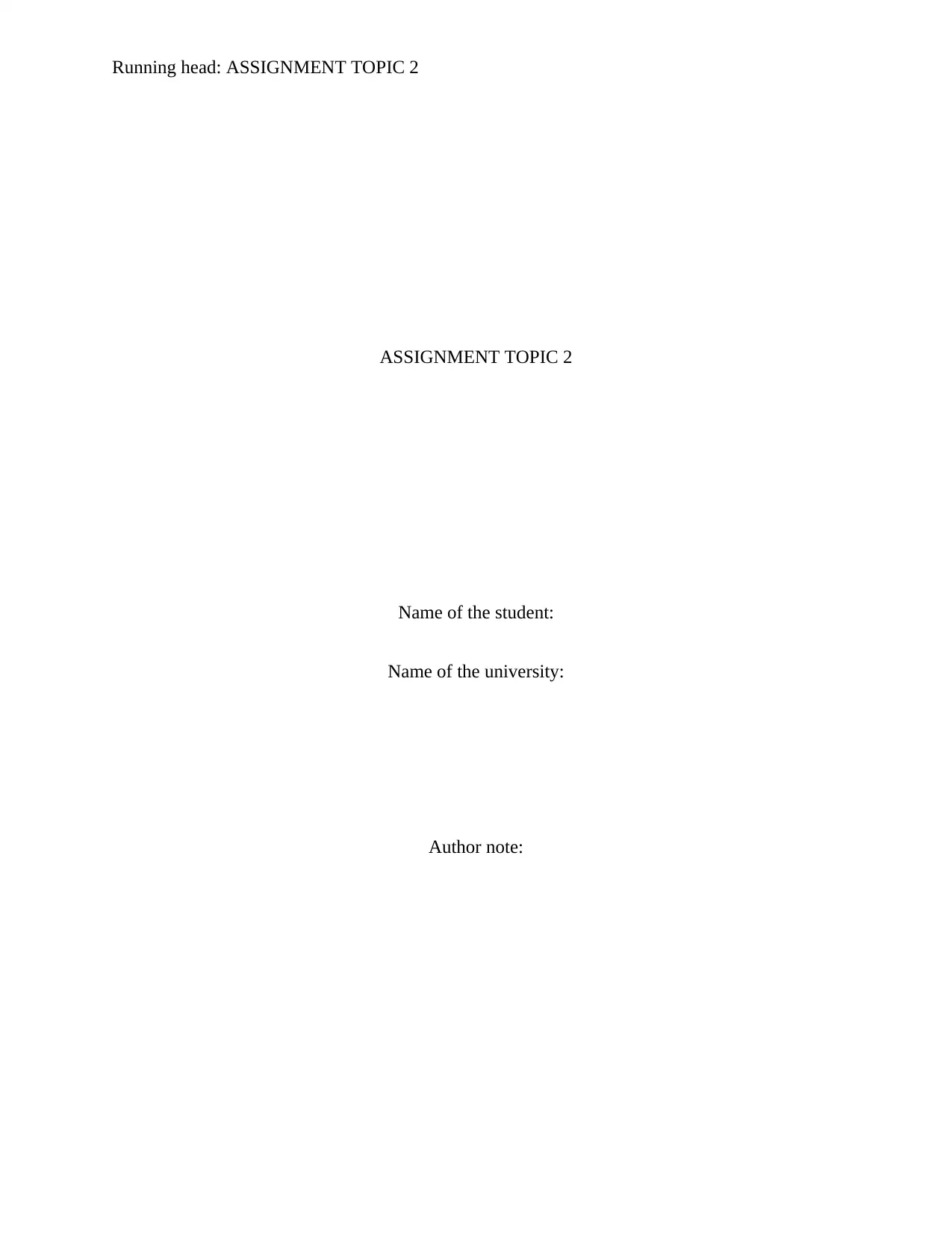
Running head: ASSIGNMENT TOPIC 2
ASSIGNMENT TOPIC 2
Name of the student:
Name of the university:
Author note:
ASSIGNMENT TOPIC 2
Name of the student:
Name of the university:
Author note:
Paraphrase This Document
Need a fresh take? Get an instant paraphrase of this document with our AI Paraphraser
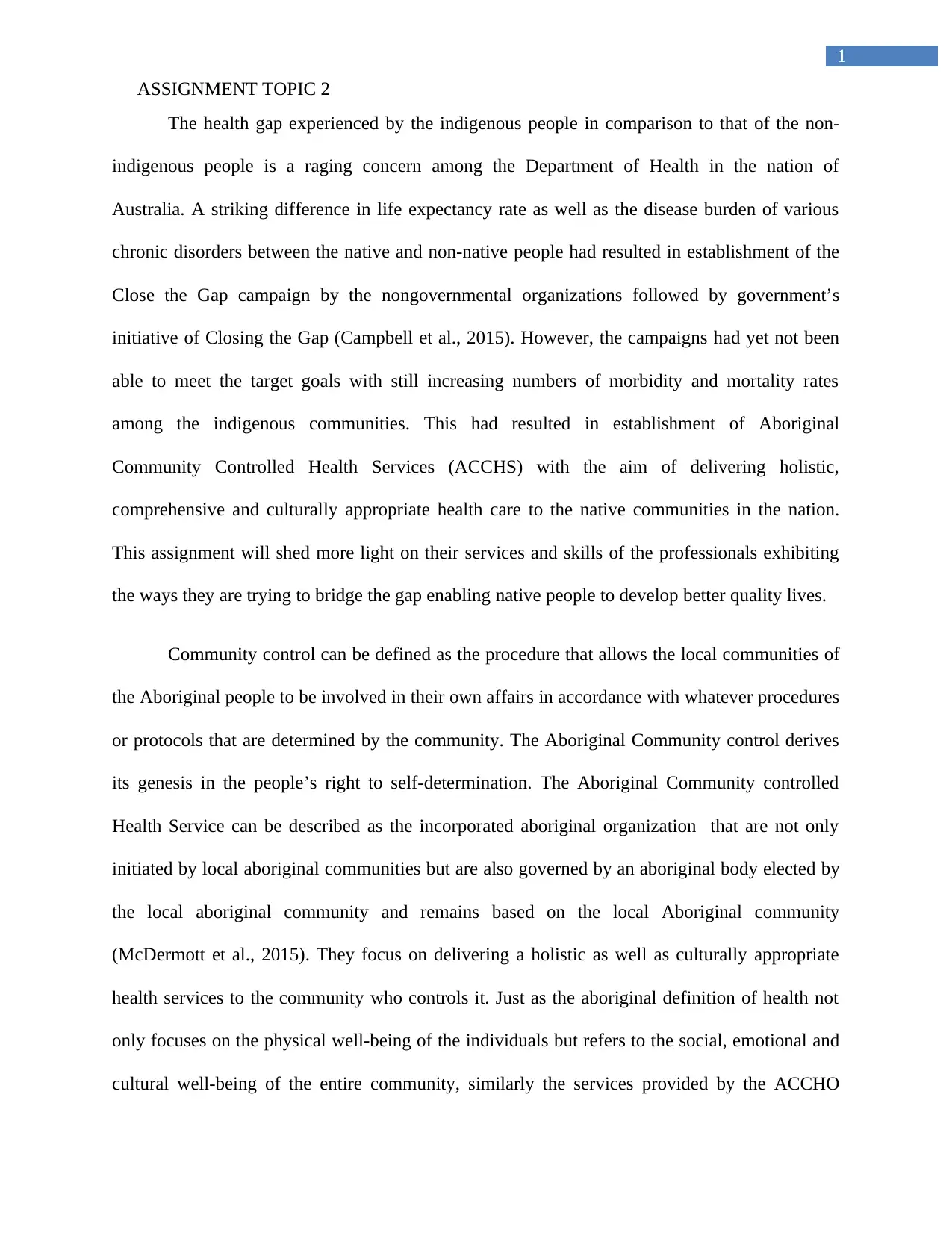
1
ASSIGNMENT TOPIC 2
The health gap experienced by the indigenous people in comparison to that of the non-
indigenous people is a raging concern among the Department of Health in the nation of
Australia. A striking difference in life expectancy rate as well as the disease burden of various
chronic disorders between the native and non-native people had resulted in establishment of the
Close the Gap campaign by the nongovernmental organizations followed by government’s
initiative of Closing the Gap (Campbell et al., 2015). However, the campaigns had yet not been
able to meet the target goals with still increasing numbers of morbidity and mortality rates
among the indigenous communities. This had resulted in establishment of Aboriginal
Community Controlled Health Services (ACCHS) with the aim of delivering holistic,
comprehensive and culturally appropriate health care to the native communities in the nation.
This assignment will shed more light on their services and skills of the professionals exhibiting
the ways they are trying to bridge the gap enabling native people to develop better quality lives.
Community control can be defined as the procedure that allows the local communities of
the Aboriginal people to be involved in their own affairs in accordance with whatever procedures
or protocols that are determined by the community. The Aboriginal Community control derives
its genesis in the people’s right to self-determination. The Aboriginal Community controlled
Health Service can be described as the incorporated aboriginal organization that are not only
initiated by local aboriginal communities but are also governed by an aboriginal body elected by
the local aboriginal community and remains based on the local Aboriginal community
(McDermott et al., 2015). They focus on delivering a holistic as well as culturally appropriate
health services to the community who controls it. Just as the aboriginal definition of health not
only focuses on the physical well-being of the individuals but refers to the social, emotional and
cultural well-being of the entire community, similarly the services provided by the ACCHO
ASSIGNMENT TOPIC 2
The health gap experienced by the indigenous people in comparison to that of the non-
indigenous people is a raging concern among the Department of Health in the nation of
Australia. A striking difference in life expectancy rate as well as the disease burden of various
chronic disorders between the native and non-native people had resulted in establishment of the
Close the Gap campaign by the nongovernmental organizations followed by government’s
initiative of Closing the Gap (Campbell et al., 2015). However, the campaigns had yet not been
able to meet the target goals with still increasing numbers of morbidity and mortality rates
among the indigenous communities. This had resulted in establishment of Aboriginal
Community Controlled Health Services (ACCHS) with the aim of delivering holistic,
comprehensive and culturally appropriate health care to the native communities in the nation.
This assignment will shed more light on their services and skills of the professionals exhibiting
the ways they are trying to bridge the gap enabling native people to develop better quality lives.
Community control can be defined as the procedure that allows the local communities of
the Aboriginal people to be involved in their own affairs in accordance with whatever procedures
or protocols that are determined by the community. The Aboriginal Community control derives
its genesis in the people’s right to self-determination. The Aboriginal Community controlled
Health Service can be described as the incorporated aboriginal organization that are not only
initiated by local aboriginal communities but are also governed by an aboriginal body elected by
the local aboriginal community and remains based on the local Aboriginal community
(McDermott et al., 2015). They focus on delivering a holistic as well as culturally appropriate
health services to the community who controls it. Just as the aboriginal definition of health not
only focuses on the physical well-being of the individuals but refers to the social, emotional and
cultural well-being of the entire community, similarly the services provided by the ACCHO
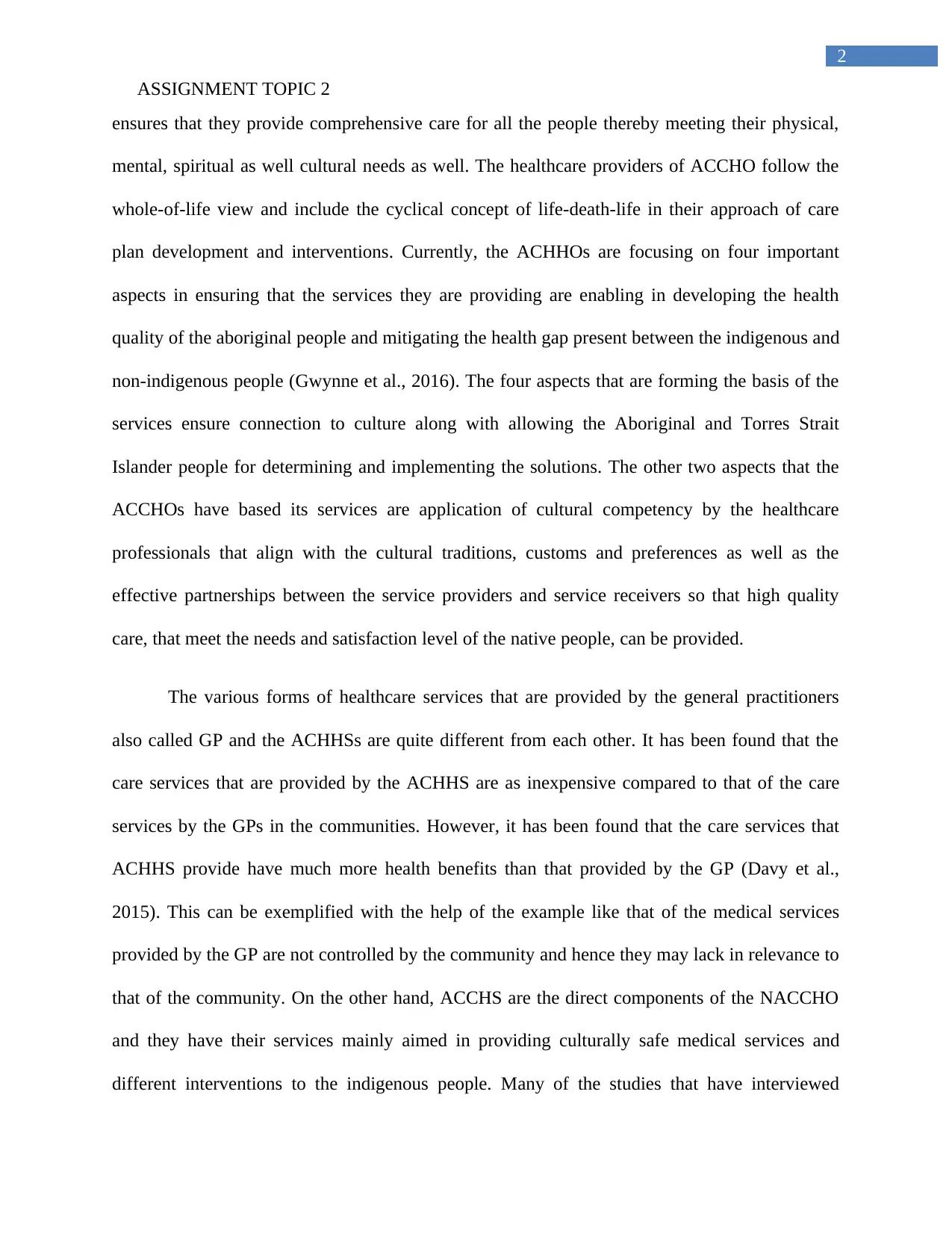
2
ASSIGNMENT TOPIC 2
ensures that they provide comprehensive care for all the people thereby meeting their physical,
mental, spiritual as well cultural needs as well. The healthcare providers of ACCHO follow the
whole-of-life view and include the cyclical concept of life-death-life in their approach of care
plan development and interventions. Currently, the ACHHOs are focusing on four important
aspects in ensuring that the services they are providing are enabling in developing the health
quality of the aboriginal people and mitigating the health gap present between the indigenous and
non-indigenous people (Gwynne et al., 2016). The four aspects that are forming the basis of the
services ensure connection to culture along with allowing the Aboriginal and Torres Strait
Islander people for determining and implementing the solutions. The other two aspects that the
ACCHOs have based its services are application of cultural competency by the healthcare
professionals that align with the cultural traditions, customs and preferences as well as the
effective partnerships between the service providers and service receivers so that high quality
care, that meet the needs and satisfaction level of the native people, can be provided.
The various forms of healthcare services that are provided by the general practitioners
also called GP and the ACHHSs are quite different from each other. It has been found that the
care services that are provided by the ACHHS are as inexpensive compared to that of the care
services by the GPs in the communities. However, it has been found that the care services that
ACHHS provide have much more health benefits than that provided by the GP (Davy et al.,
2015). This can be exemplified with the help of the example like that of the medical services
provided by the GP are not controlled by the community and hence they may lack in relevance to
that of the community. On the other hand, ACCHS are the direct components of the NACCHO
and they have their services mainly aimed in providing culturally safe medical services and
different interventions to the indigenous people. Many of the studies that have interviewed
ASSIGNMENT TOPIC 2
ensures that they provide comprehensive care for all the people thereby meeting their physical,
mental, spiritual as well cultural needs as well. The healthcare providers of ACCHO follow the
whole-of-life view and include the cyclical concept of life-death-life in their approach of care
plan development and interventions. Currently, the ACHHOs are focusing on four important
aspects in ensuring that the services they are providing are enabling in developing the health
quality of the aboriginal people and mitigating the health gap present between the indigenous and
non-indigenous people (Gwynne et al., 2016). The four aspects that are forming the basis of the
services ensure connection to culture along with allowing the Aboriginal and Torres Strait
Islander people for determining and implementing the solutions. The other two aspects that the
ACCHOs have based its services are application of cultural competency by the healthcare
professionals that align with the cultural traditions, customs and preferences as well as the
effective partnerships between the service providers and service receivers so that high quality
care, that meet the needs and satisfaction level of the native people, can be provided.
The various forms of healthcare services that are provided by the general practitioners
also called GP and the ACHHSs are quite different from each other. It has been found that the
care services that are provided by the ACHHS are as inexpensive compared to that of the care
services by the GPs in the communities. However, it has been found that the care services that
ACHHS provide have much more health benefits than that provided by the GP (Davy et al.,
2015). This can be exemplified with the help of the example like that of the medical services
provided by the GP are not controlled by the community and hence they may lack in relevance to
that of the community. On the other hand, ACCHS are the direct components of the NACCHO
and they have their services mainly aimed in providing culturally safe medical services and
different interventions to the indigenous people. Many of the studies that have interviewed
⊘ This is a preview!⊘
Do you want full access?
Subscribe today to unlock all pages.

Trusted by 1+ million students worldwide
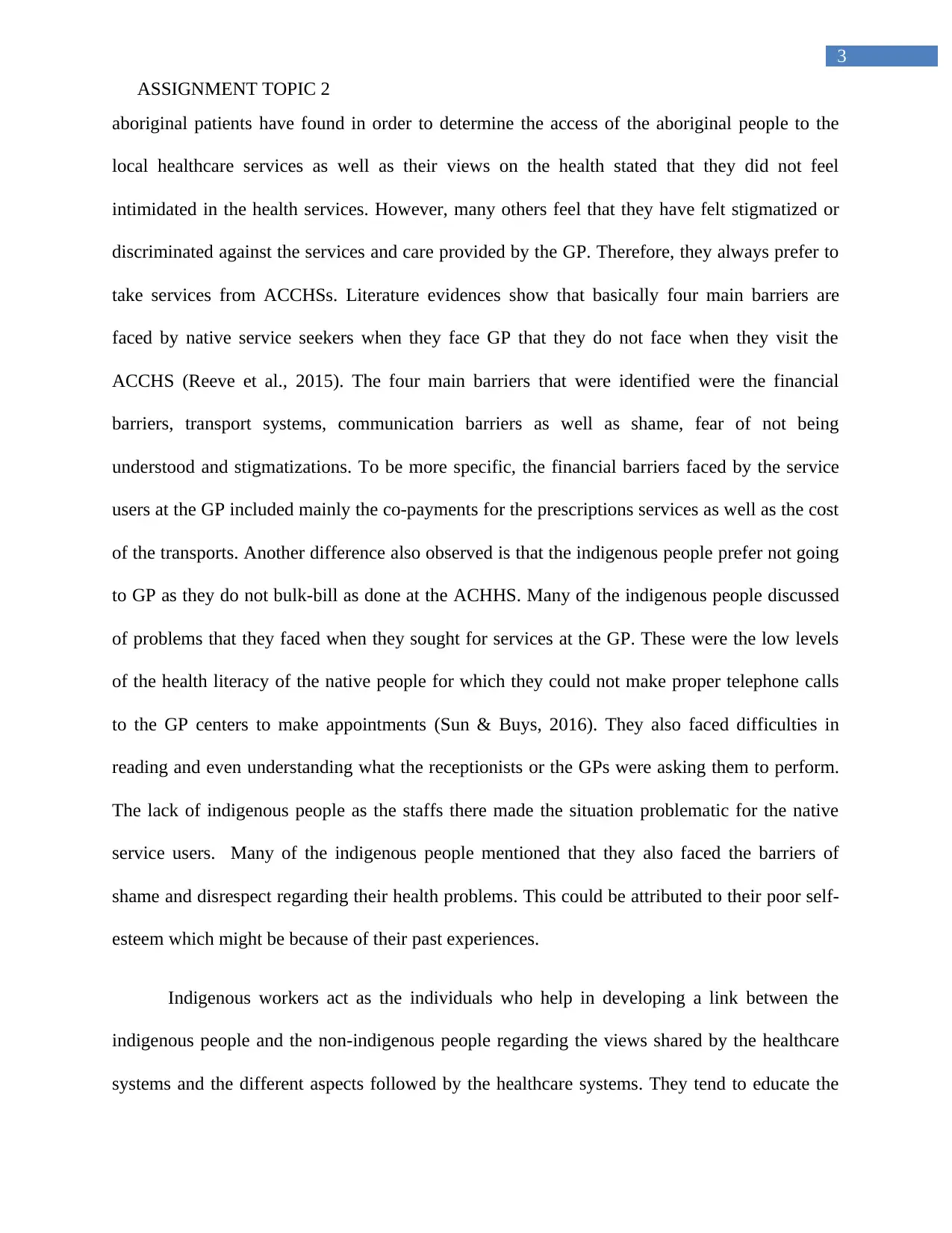
3
ASSIGNMENT TOPIC 2
aboriginal patients have found in order to determine the access of the aboriginal people to the
local healthcare services as well as their views on the health stated that they did not feel
intimidated in the health services. However, many others feel that they have felt stigmatized or
discriminated against the services and care provided by the GP. Therefore, they always prefer to
take services from ACCHSs. Literature evidences show that basically four main barriers are
faced by native service seekers when they face GP that they do not face when they visit the
ACCHS (Reeve et al., 2015). The four main barriers that were identified were the financial
barriers, transport systems, communication barriers as well as shame, fear of not being
understood and stigmatizations. To be more specific, the financial barriers faced by the service
users at the GP included mainly the co-payments for the prescriptions services as well as the cost
of the transports. Another difference also observed is that the indigenous people prefer not going
to GP as they do not bulk-bill as done at the ACHHS. Many of the indigenous people discussed
of problems that they faced when they sought for services at the GP. These were the low levels
of the health literacy of the native people for which they could not make proper telephone calls
to the GP centers to make appointments (Sun & Buys, 2016). They also faced difficulties in
reading and even understanding what the receptionists or the GPs were asking them to perform.
The lack of indigenous people as the staffs there made the situation problematic for the native
service users. Many of the indigenous people mentioned that they also faced the barriers of
shame and disrespect regarding their health problems. This could be attributed to their poor self-
esteem which might be because of their past experiences.
Indigenous workers act as the individuals who help in developing a link between the
indigenous people and the non-indigenous people regarding the views shared by the healthcare
systems and the different aspects followed by the healthcare systems. They tend to educate the
ASSIGNMENT TOPIC 2
aboriginal patients have found in order to determine the access of the aboriginal people to the
local healthcare services as well as their views on the health stated that they did not feel
intimidated in the health services. However, many others feel that they have felt stigmatized or
discriminated against the services and care provided by the GP. Therefore, they always prefer to
take services from ACCHSs. Literature evidences show that basically four main barriers are
faced by native service seekers when they face GP that they do not face when they visit the
ACCHS (Reeve et al., 2015). The four main barriers that were identified were the financial
barriers, transport systems, communication barriers as well as shame, fear of not being
understood and stigmatizations. To be more specific, the financial barriers faced by the service
users at the GP included mainly the co-payments for the prescriptions services as well as the cost
of the transports. Another difference also observed is that the indigenous people prefer not going
to GP as they do not bulk-bill as done at the ACHHS. Many of the indigenous people discussed
of problems that they faced when they sought for services at the GP. These were the low levels
of the health literacy of the native people for which they could not make proper telephone calls
to the GP centers to make appointments (Sun & Buys, 2016). They also faced difficulties in
reading and even understanding what the receptionists or the GPs were asking them to perform.
The lack of indigenous people as the staffs there made the situation problematic for the native
service users. Many of the indigenous people mentioned that they also faced the barriers of
shame and disrespect regarding their health problems. This could be attributed to their poor self-
esteem which might be because of their past experiences.
Indigenous workers act as the individuals who help in developing a link between the
indigenous people and the non-indigenous people regarding the views shared by the healthcare
systems and the different aspects followed by the healthcare systems. They tend to educate the
Paraphrase This Document
Need a fresh take? Get an instant paraphrase of this document with our AI Paraphraser
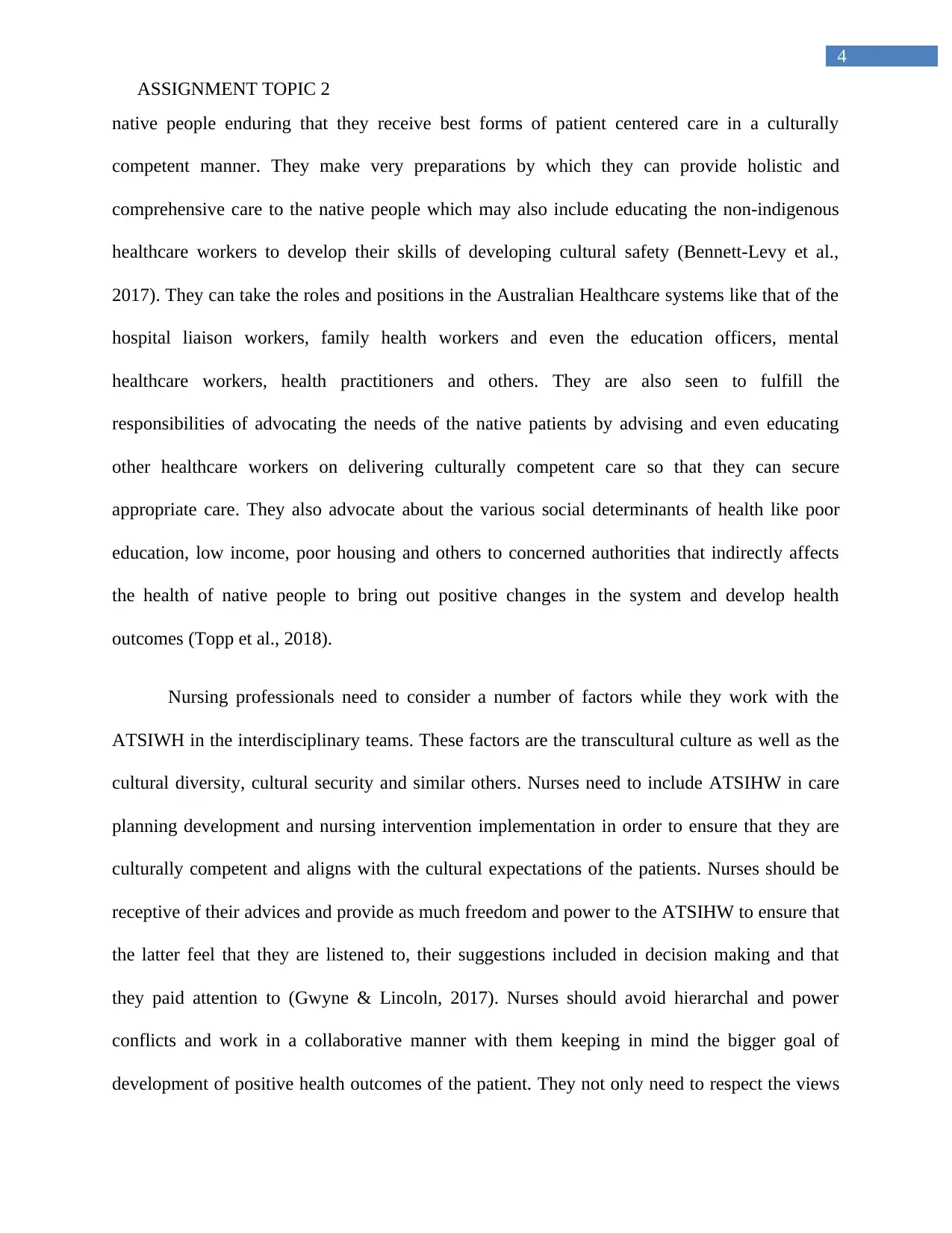
4
ASSIGNMENT TOPIC 2
native people enduring that they receive best forms of patient centered care in a culturally
competent manner. They make very preparations by which they can provide holistic and
comprehensive care to the native people which may also include educating the non-indigenous
healthcare workers to develop their skills of developing cultural safety (Bennett-Levy et al.,
2017). They can take the roles and positions in the Australian Healthcare systems like that of the
hospital liaison workers, family health workers and even the education officers, mental
healthcare workers, health practitioners and others. They are also seen to fulfill the
responsibilities of advocating the needs of the native patients by advising and even educating
other healthcare workers on delivering culturally competent care so that they can secure
appropriate care. They also advocate about the various social determinants of health like poor
education, low income, poor housing and others to concerned authorities that indirectly affects
the health of native people to bring out positive changes in the system and develop health
outcomes (Topp et al., 2018).
Nursing professionals need to consider a number of factors while they work with the
ATSIWH in the interdisciplinary teams. These factors are the transcultural culture as well as the
cultural diversity, cultural security and similar others. Nurses need to include ATSIHW in care
planning development and nursing intervention implementation in order to ensure that they are
culturally competent and aligns with the cultural expectations of the patients. Nurses should be
receptive of their advices and provide as much freedom and power to the ATSIHW to ensure that
the latter feel that they are listened to, their suggestions included in decision making and that
they paid attention to (Gwyne & Lincoln, 2017). Nurses should avoid hierarchal and power
conflicts and work in a collaborative manner with them keeping in mind the bigger goal of
development of positive health outcomes of the patient. They not only need to respect the views
ASSIGNMENT TOPIC 2
native people enduring that they receive best forms of patient centered care in a culturally
competent manner. They make very preparations by which they can provide holistic and
comprehensive care to the native people which may also include educating the non-indigenous
healthcare workers to develop their skills of developing cultural safety (Bennett-Levy et al.,
2017). They can take the roles and positions in the Australian Healthcare systems like that of the
hospital liaison workers, family health workers and even the education officers, mental
healthcare workers, health practitioners and others. They are also seen to fulfill the
responsibilities of advocating the needs of the native patients by advising and even educating
other healthcare workers on delivering culturally competent care so that they can secure
appropriate care. They also advocate about the various social determinants of health like poor
education, low income, poor housing and others to concerned authorities that indirectly affects
the health of native people to bring out positive changes in the system and develop health
outcomes (Topp et al., 2018).
Nursing professionals need to consider a number of factors while they work with the
ATSIWH in the interdisciplinary teams. These factors are the transcultural culture as well as the
cultural diversity, cultural security and similar others. Nurses need to include ATSIHW in care
planning development and nursing intervention implementation in order to ensure that they are
culturally competent and aligns with the cultural expectations of the patients. Nurses should be
receptive of their advices and provide as much freedom and power to the ATSIHW to ensure that
the latter feel that they are listened to, their suggestions included in decision making and that
they paid attention to (Gwyne & Lincoln, 2017). Nurses should avoid hierarchal and power
conflicts and work in a collaborative manner with them keeping in mind the bigger goal of
development of positive health outcomes of the patient. They not only need to respect the views
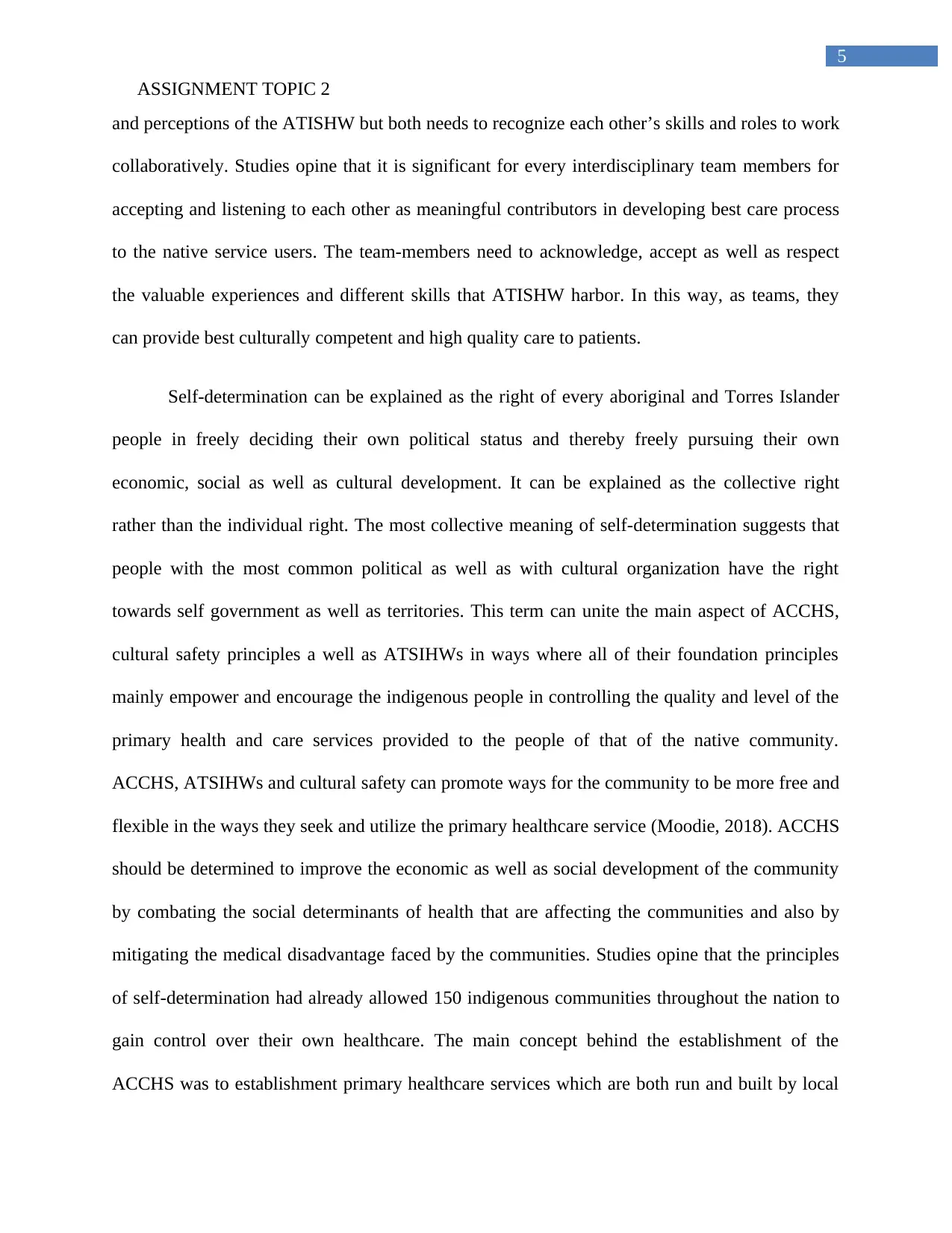
5
ASSIGNMENT TOPIC 2
and perceptions of the ATISHW but both needs to recognize each other’s skills and roles to work
collaboratively. Studies opine that it is significant for every interdisciplinary team members for
accepting and listening to each other as meaningful contributors in developing best care process
to the native service users. The team-members need to acknowledge, accept as well as respect
the valuable experiences and different skills that ATISHW harbor. In this way, as teams, they
can provide best culturally competent and high quality care to patients.
Self-determination can be explained as the right of every aboriginal and Torres Islander
people in freely deciding their own political status and thereby freely pursuing their own
economic, social as well as cultural development. It can be explained as the collective right
rather than the individual right. The most collective meaning of self-determination suggests that
people with the most common political as well as with cultural organization have the right
towards self government as well as territories. This term can unite the main aspect of ACCHS,
cultural safety principles a well as ATSIHWs in ways where all of their foundation principles
mainly empower and encourage the indigenous people in controlling the quality and level of the
primary health and care services provided to the people of that of the native community.
ACCHS, ATSIHWs and cultural safety can promote ways for the community to be more free and
flexible in the ways they seek and utilize the primary healthcare service (Moodie, 2018). ACCHS
should be determined to improve the economic as well as social development of the community
by combating the social determinants of health that are affecting the communities and also by
mitigating the medical disadvantage faced by the communities. Studies opine that the principles
of self-determination had already allowed 150 indigenous communities throughout the nation to
gain control over their own healthcare. The main concept behind the establishment of the
ACCHS was to establishment primary healthcare services which are both run and built by local
ASSIGNMENT TOPIC 2
and perceptions of the ATISHW but both needs to recognize each other’s skills and roles to work
collaboratively. Studies opine that it is significant for every interdisciplinary team members for
accepting and listening to each other as meaningful contributors in developing best care process
to the native service users. The team-members need to acknowledge, accept as well as respect
the valuable experiences and different skills that ATISHW harbor. In this way, as teams, they
can provide best culturally competent and high quality care to patients.
Self-determination can be explained as the right of every aboriginal and Torres Islander
people in freely deciding their own political status and thereby freely pursuing their own
economic, social as well as cultural development. It can be explained as the collective right
rather than the individual right. The most collective meaning of self-determination suggests that
people with the most common political as well as with cultural organization have the right
towards self government as well as territories. This term can unite the main aspect of ACCHS,
cultural safety principles a well as ATSIHWs in ways where all of their foundation principles
mainly empower and encourage the indigenous people in controlling the quality and level of the
primary health and care services provided to the people of that of the native community.
ACCHS, ATSIHWs and cultural safety can promote ways for the community to be more free and
flexible in the ways they seek and utilize the primary healthcare service (Moodie, 2018). ACCHS
should be determined to improve the economic as well as social development of the community
by combating the social determinants of health that are affecting the communities and also by
mitigating the medical disadvantage faced by the communities. Studies opine that the principles
of self-determination had already allowed 150 indigenous communities throughout the nation to
gain control over their own healthcare. The main concept behind the establishment of the
ACCHS was to establishment primary healthcare services which are both run and built by local
⊘ This is a preview!⊘
Do you want full access?
Subscribe today to unlock all pages.

Trusted by 1+ million students worldwide
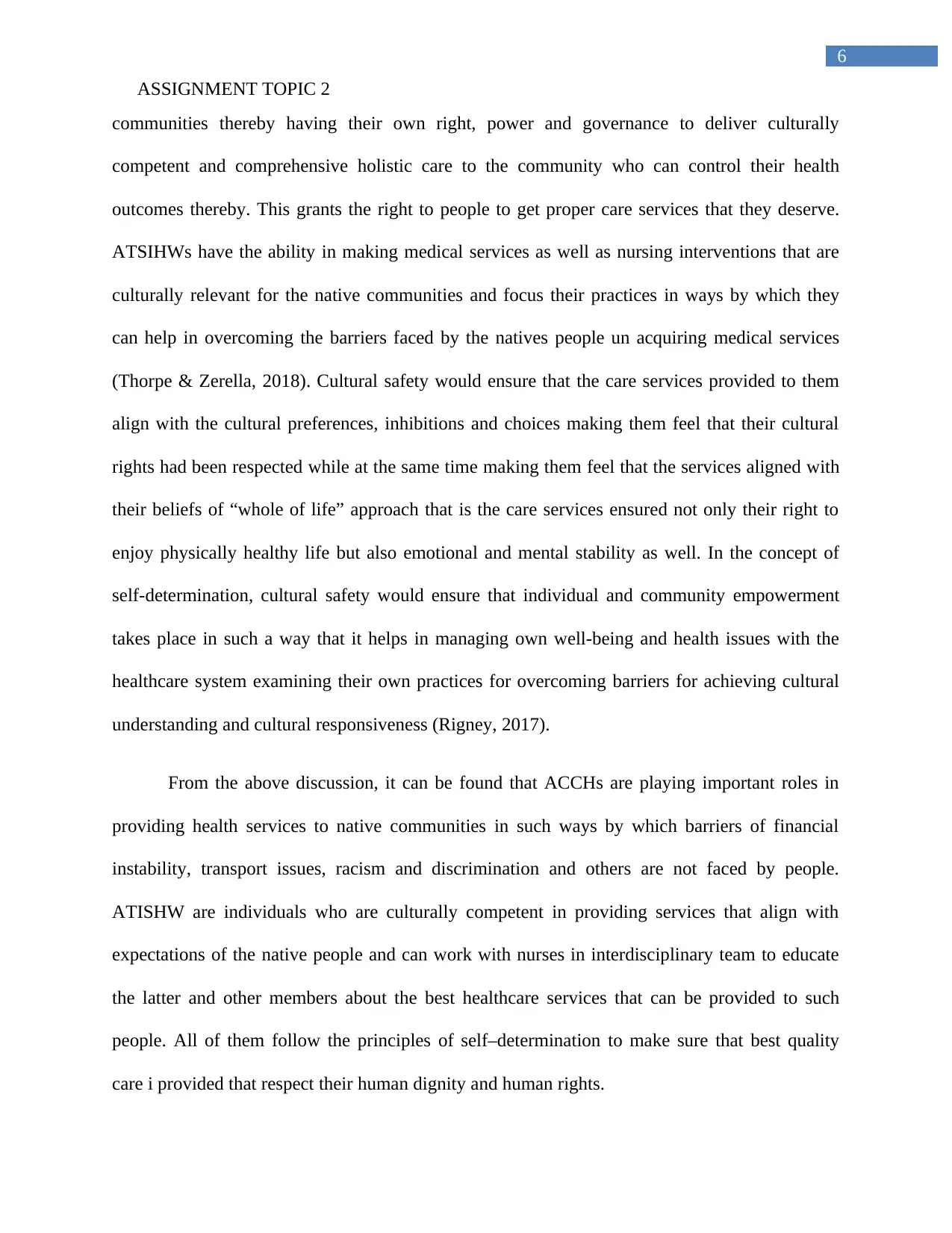
6
ASSIGNMENT TOPIC 2
communities thereby having their own right, power and governance to deliver culturally
competent and comprehensive holistic care to the community who can control their health
outcomes thereby. This grants the right to people to get proper care services that they deserve.
ATSIHWs have the ability in making medical services as well as nursing interventions that are
culturally relevant for the native communities and focus their practices in ways by which they
can help in overcoming the barriers faced by the natives people un acquiring medical services
(Thorpe & Zerella, 2018). Cultural safety would ensure that the care services provided to them
align with the cultural preferences, inhibitions and choices making them feel that their cultural
rights had been respected while at the same time making them feel that the services aligned with
their beliefs of “whole of life” approach that is the care services ensured not only their right to
enjoy physically healthy life but also emotional and mental stability as well. In the concept of
self-determination, cultural safety would ensure that individual and community empowerment
takes place in such a way that it helps in managing own well-being and health issues with the
healthcare system examining their own practices for overcoming barriers for achieving cultural
understanding and cultural responsiveness (Rigney, 2017).
From the above discussion, it can be found that ACCHs are playing important roles in
providing health services to native communities in such ways by which barriers of financial
instability, transport issues, racism and discrimination and others are not faced by people.
ATISHW are individuals who are culturally competent in providing services that align with
expectations of the native people and can work with nurses in interdisciplinary team to educate
the latter and other members about the best healthcare services that can be provided to such
people. All of them follow the principles of self–determination to make sure that best quality
care i provided that respect their human dignity and human rights.
ASSIGNMENT TOPIC 2
communities thereby having their own right, power and governance to deliver culturally
competent and comprehensive holistic care to the community who can control their health
outcomes thereby. This grants the right to people to get proper care services that they deserve.
ATSIHWs have the ability in making medical services as well as nursing interventions that are
culturally relevant for the native communities and focus their practices in ways by which they
can help in overcoming the barriers faced by the natives people un acquiring medical services
(Thorpe & Zerella, 2018). Cultural safety would ensure that the care services provided to them
align with the cultural preferences, inhibitions and choices making them feel that their cultural
rights had been respected while at the same time making them feel that the services aligned with
their beliefs of “whole of life” approach that is the care services ensured not only their right to
enjoy physically healthy life but also emotional and mental stability as well. In the concept of
self-determination, cultural safety would ensure that individual and community empowerment
takes place in such a way that it helps in managing own well-being and health issues with the
healthcare system examining their own practices for overcoming barriers for achieving cultural
understanding and cultural responsiveness (Rigney, 2017).
From the above discussion, it can be found that ACCHs are playing important roles in
providing health services to native communities in such ways by which barriers of financial
instability, transport issues, racism and discrimination and others are not faced by people.
ATISHW are individuals who are culturally competent in providing services that align with
expectations of the native people and can work with nurses in interdisciplinary team to educate
the latter and other members about the best healthcare services that can be provided to such
people. All of them follow the principles of self–determination to make sure that best quality
care i provided that respect their human dignity and human rights.
Paraphrase This Document
Need a fresh take? Get an instant paraphrase of this document with our AI Paraphraser
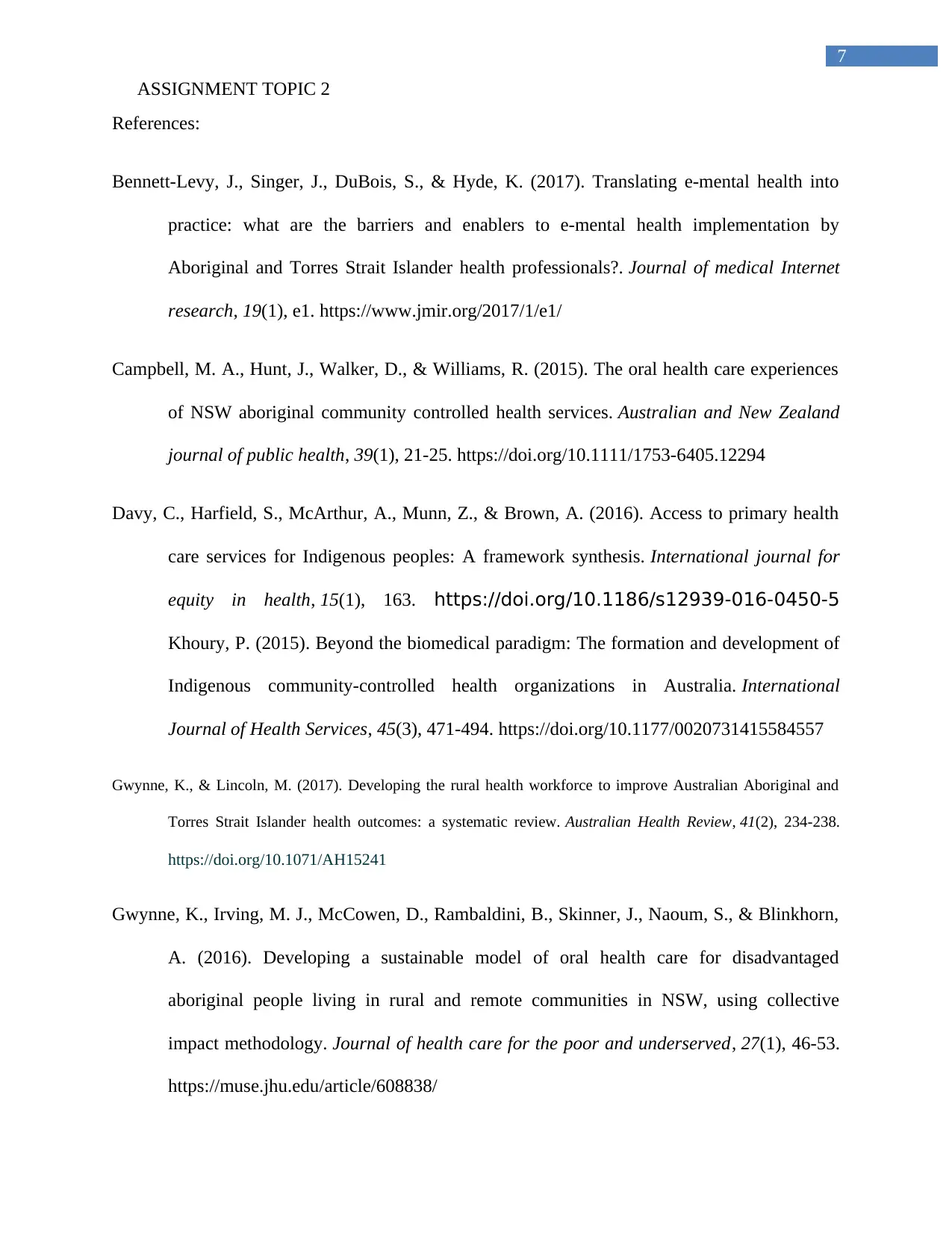
7
ASSIGNMENT TOPIC 2
References:
Bennett-Levy, J., Singer, J., DuBois, S., & Hyde, K. (2017). Translating e-mental health into
practice: what are the barriers and enablers to e-mental health implementation by
Aboriginal and Torres Strait Islander health professionals?. Journal of medical Internet
research, 19(1), e1. https://www.jmir.org/2017/1/e1/
Campbell, M. A., Hunt, J., Walker, D., & Williams, R. (2015). The oral health care experiences
of NSW aboriginal community controlled health services. Australian and New Zealand
journal of public health, 39(1), 21-25. https://doi.org/10.1111/1753-6405.12294
Davy, C., Harfield, S., McArthur, A., Munn, Z., & Brown, A. (2016). Access to primary health
care services for Indigenous peoples: A framework synthesis. International journal for
equity in health, 15(1), 163. https://doi.org/10.1186/s12939-016-0450-5
Khoury, P. (2015). Beyond the biomedical paradigm: The formation and development of
Indigenous community-controlled health organizations in Australia. International
Journal of Health Services, 45(3), 471-494. https://doi.org/10.1177/0020731415584557
Gwynne, K., & Lincoln, M. (2017). Developing the rural health workforce to improve Australian Aboriginal and
Torres Strait Islander health outcomes: a systematic review. Australian Health Review, 41(2), 234-238.
https://doi.org/10.1071/AH15241
Gwynne, K., Irving, M. J., McCowen, D., Rambaldini, B., Skinner, J., Naoum, S., & Blinkhorn,
A. (2016). Developing a sustainable model of oral health care for disadvantaged
aboriginal people living in rural and remote communities in NSW, using collective
impact methodology. Journal of health care for the poor and underserved, 27(1), 46-53.
https://muse.jhu.edu/article/608838/
ASSIGNMENT TOPIC 2
References:
Bennett-Levy, J., Singer, J., DuBois, S., & Hyde, K. (2017). Translating e-mental health into
practice: what are the barriers and enablers to e-mental health implementation by
Aboriginal and Torres Strait Islander health professionals?. Journal of medical Internet
research, 19(1), e1. https://www.jmir.org/2017/1/e1/
Campbell, M. A., Hunt, J., Walker, D., & Williams, R. (2015). The oral health care experiences
of NSW aboriginal community controlled health services. Australian and New Zealand
journal of public health, 39(1), 21-25. https://doi.org/10.1111/1753-6405.12294
Davy, C., Harfield, S., McArthur, A., Munn, Z., & Brown, A. (2016). Access to primary health
care services for Indigenous peoples: A framework synthesis. International journal for
equity in health, 15(1), 163. https://doi.org/10.1186/s12939-016-0450-5
Khoury, P. (2015). Beyond the biomedical paradigm: The formation and development of
Indigenous community-controlled health organizations in Australia. International
Journal of Health Services, 45(3), 471-494. https://doi.org/10.1177/0020731415584557
Gwynne, K., & Lincoln, M. (2017). Developing the rural health workforce to improve Australian Aboriginal and
Torres Strait Islander health outcomes: a systematic review. Australian Health Review, 41(2), 234-238.
https://doi.org/10.1071/AH15241
Gwynne, K., Irving, M. J., McCowen, D., Rambaldini, B., Skinner, J., Naoum, S., & Blinkhorn,
A. (2016). Developing a sustainable model of oral health care for disadvantaged
aboriginal people living in rural and remote communities in NSW, using collective
impact methodology. Journal of health care for the poor and underserved, 27(1), 46-53.
https://muse.jhu.edu/article/608838/
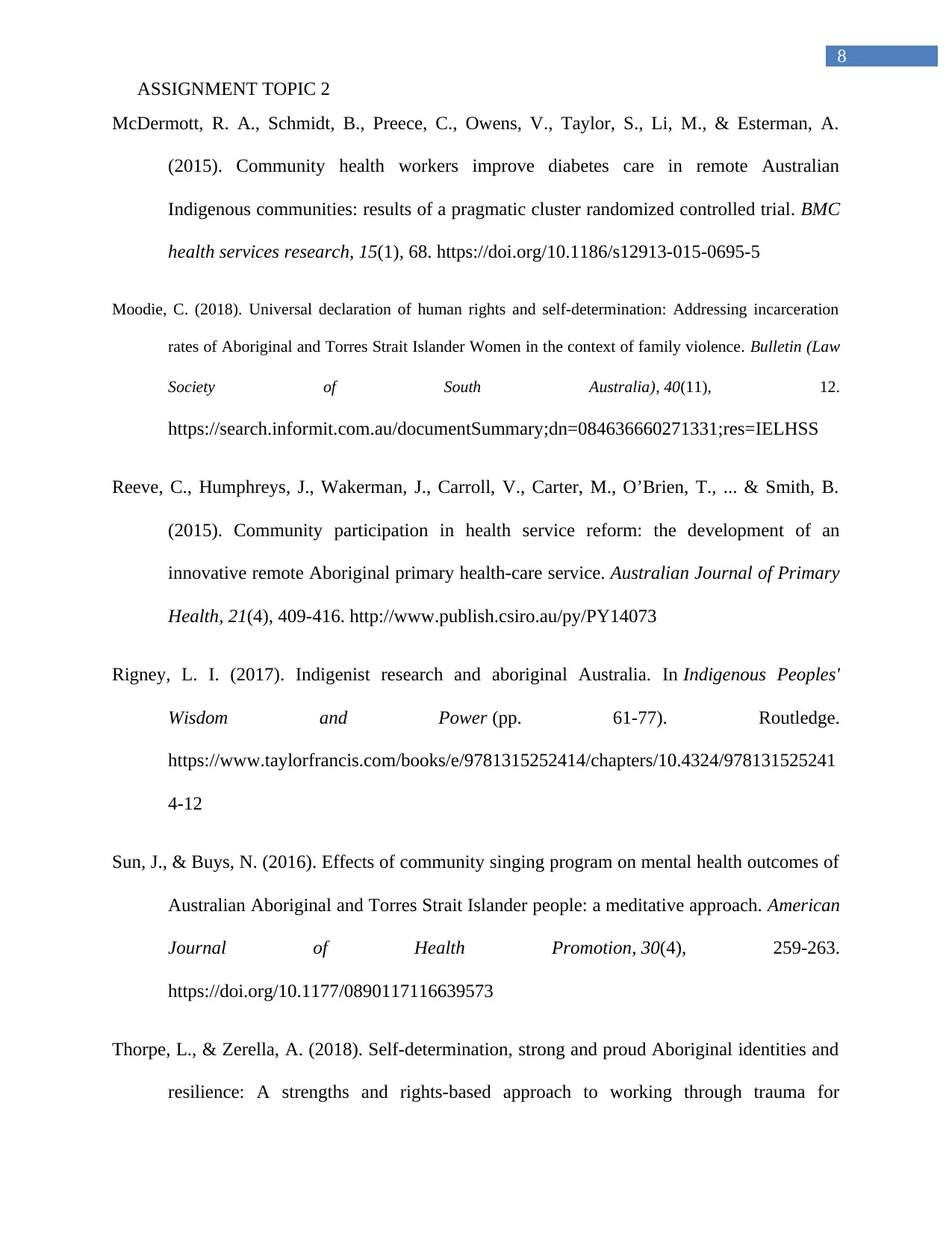
8
ASSIGNMENT TOPIC 2
McDermott, R. A., Schmidt, B., Preece, C., Owens, V., Taylor, S., Li, M., & Esterman, A.
(2015). Community health workers improve diabetes care in remote Australian
Indigenous communities: results of a pragmatic cluster randomized controlled trial. BMC
health services research, 15(1), 68. https://doi.org/10.1186/s12913-015-0695-5
Moodie, C. (2018). Universal declaration of human rights and self-determination: Addressing incarceration
rates of Aboriginal and Torres Strait Islander Women in the context of family violence. Bulletin (Law
Society of South Australia), 40(11), 12.
https://search.informit.com.au/documentSummary;dn=084636660271331;res=IELHSS
Reeve, C., Humphreys, J., Wakerman, J., Carroll, V., Carter, M., O’Brien, T., ... & Smith, B.
(2015). Community participation in health service reform: the development of an
innovative remote Aboriginal primary health-care service. Australian Journal of Primary
Health, 21(4), 409-416. http://www.publish.csiro.au/py/PY14073
Rigney, L. I. (2017). Indigenist research and aboriginal Australia. In Indigenous Peoples'
Wisdom and Power (pp. 61-77). Routledge.
https://www.taylorfrancis.com/books/e/9781315252414/chapters/10.4324/978131525241
4-12
Sun, J., & Buys, N. (2016). Effects of community singing program on mental health outcomes of
Australian Aboriginal and Torres Strait Islander people: a meditative approach. American
Journal of Health Promotion, 30(4), 259-263.
https://doi.org/10.1177/0890117116639573
Thorpe, L., & Zerella, A. (2018). Self-determination, strong and proud Aboriginal identities and
resilience: A strengths and rights-based approach to working through trauma for
ASSIGNMENT TOPIC 2
McDermott, R. A., Schmidt, B., Preece, C., Owens, V., Taylor, S., Li, M., & Esterman, A.
(2015). Community health workers improve diabetes care in remote Australian
Indigenous communities: results of a pragmatic cluster randomized controlled trial. BMC
health services research, 15(1), 68. https://doi.org/10.1186/s12913-015-0695-5
Moodie, C. (2018). Universal declaration of human rights and self-determination: Addressing incarceration
rates of Aboriginal and Torres Strait Islander Women in the context of family violence. Bulletin (Law
Society of South Australia), 40(11), 12.
https://search.informit.com.au/documentSummary;dn=084636660271331;res=IELHSS
Reeve, C., Humphreys, J., Wakerman, J., Carroll, V., Carter, M., O’Brien, T., ... & Smith, B.
(2015). Community participation in health service reform: the development of an
innovative remote Aboriginal primary health-care service. Australian Journal of Primary
Health, 21(4), 409-416. http://www.publish.csiro.au/py/PY14073
Rigney, L. I. (2017). Indigenist research and aboriginal Australia. In Indigenous Peoples'
Wisdom and Power (pp. 61-77). Routledge.
https://www.taylorfrancis.com/books/e/9781315252414/chapters/10.4324/978131525241
4-12
Sun, J., & Buys, N. (2016). Effects of community singing program on mental health outcomes of
Australian Aboriginal and Torres Strait Islander people: a meditative approach. American
Journal of Health Promotion, 30(4), 259-263.
https://doi.org/10.1177/0890117116639573
Thorpe, L., & Zerella, A. (2018). Self-determination, strong and proud Aboriginal identities and
resilience: A strengths and rights-based approach to working through trauma for
⊘ This is a preview!⊘
Do you want full access?
Subscribe today to unlock all pages.

Trusted by 1+ million students worldwide
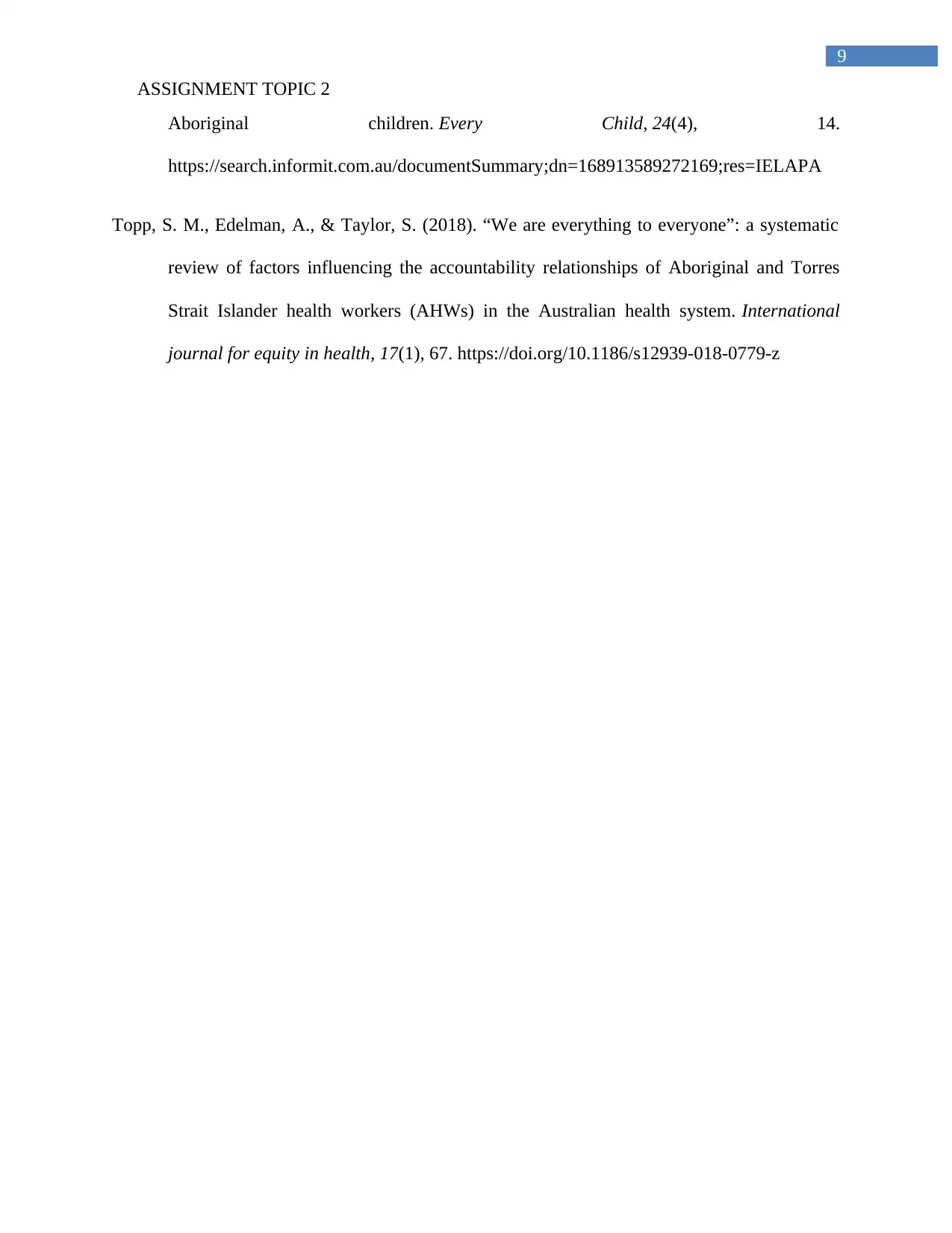
9
ASSIGNMENT TOPIC 2
Aboriginal children. Every Child, 24(4), 14.
https://search.informit.com.au/documentSummary;dn=168913589272169;res=IELAPA
Topp, S. M., Edelman, A., & Taylor, S. (2018). “We are everything to everyone”: a systematic
review of factors influencing the accountability relationships of Aboriginal and Torres
Strait Islander health workers (AHWs) in the Australian health system. International
journal for equity in health, 17(1), 67. https://doi.org/10.1186/s12939-018-0779-z
ASSIGNMENT TOPIC 2
Aboriginal children. Every Child, 24(4), 14.
https://search.informit.com.au/documentSummary;dn=168913589272169;res=IELAPA
Topp, S. M., Edelman, A., & Taylor, S. (2018). “We are everything to everyone”: a systematic
review of factors influencing the accountability relationships of Aboriginal and Torres
Strait Islander health workers (AHWs) in the Australian health system. International
journal for equity in health, 17(1), 67. https://doi.org/10.1186/s12939-018-0779-z
1 out of 10
Related Documents
Your All-in-One AI-Powered Toolkit for Academic Success.
+13062052269
info@desklib.com
Available 24*7 on WhatsApp / Email
![[object Object]](/_next/static/media/star-bottom.7253800d.svg)
Unlock your academic potential
Copyright © 2020–2025 A2Z Services. All Rights Reserved. Developed and managed by ZUCOL.




